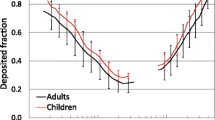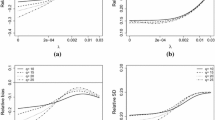Abstract
We expanded a previously published (Vijayaraghavan et al. 1994) computerized system to analyze the breathing pattern of unanesthetized mice in order better to recognize and quantify the effects of an airborne mixture of chemicals at three different levels of the respiratory tract. The airborne chemical mixture used was a machining fluid. Such fluids are widely used in industry and a large number of workers are exposed to these airborne mixtures. We found this mixture to be capable of inducing three types of effects on the respiratory tract: sensory irritation of the upper respiratory tract (S), airflow limitation along the conducting airways (A) and pulmonary irritation (P). Depending upon the exposure concentration, mainly S or P effects were obtained but an A effect was also identified. The three types of effects occurred at various times during the exposures and, furthermore, within a group of exposed animals some exhibited one type of effect while others exhibited another type. In order to analyze such complex data sets, two statistical methods for smoothing polynomial splines were utilized: the maximum likelihood (ML) method and generalized cross validation (GCV) method. The results indicated that previous methods used to characterize a single effect of airborne chemicals can now be extended to evaluate mixtures likely to induce multiple types of effects. However, statistical analysis methods, either the ML or GCV methods, or other appropriate methods are needed to evaluate the responses obtained due to the complex effects that a mixture can induce in comparison to single chemicals.
Similar content being viewed by others
References
Alarie Y (1966) Irritating properties of airborne materials to the upper respiratory tract. Arch Environ Health 13: 433–449
Alarie Y (1973) Sensory irritation by airborne chemicals. CRC Crit Rev Toxicol 2: 299–366
Alarie Y (1981) Toxicologic evaluation of airborne chemical irritants and allergens using respiratory reflex reactions. In: Leong BKJ (ed) Proceedings of inhalation toxicology and technology symposium. Ann Arbor Science, Ann Arbor, Mich., pp 207–231
Alarie Y, Iwasaki M, Schaper M (1990) The use of whole-body plethysmograph in sedentary conditions or during exercise to determine pulmonary toxicity, including hypersensitivity, during or following exposure to airborne toxicants. J Am Coll Toxicol 9: 407–439
American Conference of Governmental Industrial Hygienists (1994–1995) Threshold Limit Values for chemical substances. Cincinnati, Ohio
Boylstein LA, Anderson SJ, Alarie Y (1995) Comparison of smoothing methods when applied to respiratory data collected in mice exposed to an aerosolized machining fluid. 154th Joint Statistical Meetings. Biopharmaceutical Section Proceedings, 12th edn (in press)
Ferguson JS, Schaper M, Stock MF, Weyel DA, Alarie Y (1986) Sensory and pulmonary irritation with exposure to methyl isocyanate. Toxicol Appl Pharmacol 82: 329–335
National Research Council (1988) Complex mixtures. Methods for in vivo toxicity testing. National Academy Press, Washington, D.C., 227 pp
Nielsen GD (1991) Mechanisms of activation of the sensory irritant receptor by airborne chemicals. CRC Crit Rev Toxicol 21: 183–208
Schaper M (1993) Development of a database for sensory irritants and its use in establishing occupational exposure limits. Am Ind Hyg Assoc J 54: 488–544
Schaper M, Detwiler K (1991) Evaluation of the acute respiratory effects of aerosolized machining fluids in mice. Fundam Appl Toxicol 16: 309–319
Vijayaraghavan R, Schaper M, Thompson R, Stock MF, Alarie Y (1993) Characteristic modifications of the breathing pattern of mice to evaluate the effects of airborne chemicals on the respiratory tract. Arch Toxicol 67: 478–490
Vijayaraghavan R, Schaper M, Thompson R, Stock MF, Boylstein LA, Luo JE, Alarie Y (1994) Computer assisted recognition and quantitation of the effects of airborne chemicals acting at different areas of the respiratory tract in mice. Arch Toxicol 68: 490–499
Wade TD, Anderson SJ, Bondy J, Ramadevi VA, Jones RH, Swanson GD (1988) Using smoothing splines to make inferences about the shape of gas-exchange curves. Comput Biomed Res 21: 16–26
Wahba G (1978) Improper priors, spline smoothing and the problem of guarding against model errors in regression. J R Statist Soc 440: 364–372
Wahba G (1985) Smoothing noisy data with spline functions. Numer Math 24: 383–393
Wecker WE, Ansley CF (1983) The signal extraction approach to nonlinear regression and spline smoothing. JASA 78: 71–89
Author information
Authors and Affiliations
Rights and permissions
About this article
Cite this article
Boylstein, L.A., Anderson, S.J., Thompson, R.D. et al. Characterization of the effects of an airborne mixture of chemicals on the respiratory tract and smoothing polynomial spline analysis of the data. Arch Toxicol 69, 579–589 (1995). https://doi.org/10.1007/s002040050217
Received:
Accepted:
Issue Date:
DOI: https://doi.org/10.1007/s002040050217




